Photosynthesis | General Awareness for SSC CGL PDF Download
Introduction
- Photosynthesis is the process by which green plants and photosynthetic bacteria convert electromagnetic radiation into chemical energy.
- During this process, light energy is used to transform carbon dioxide and water into carbohydrates and oxygen.
- The carbohydrates produced through photosynthesis provide essential energy for ecosystem processes and serve as the building blocks for various biomolecules.
- Photosynthesis involves a light-driven oxidation-reduction reaction where light energy oxidizes water, releasing oxygen gas and hydrogen ions.
- Electrons are then transferred to carbon dioxide, reducing it to organic molecules.
- Photosynthetic organisms, known as autotrophs, can create chemical fuels like glucose from carbon dioxide and water using sunlight.
- Other organisms that obtain energy from consuming other organisms ultimately rely on autotrophs for their energy needs.
- A crucial component of photosynthesis is the green pigment chlorophyll, found in the chloroplasts of green plants and certain bacteria.
- Chlorophyll captures sunlight, driving the photosynthetic process.
 Photosynthesis Reactions
Photosynthesis Reactions
The process of photosynthesis differs between green plants and sulfur bacteria. In plants, water and carbon dioxide are used to produce glucose and oxygen. For sulfur bacteria, hydrogen sulfide is used along with carbon dioxide to produce carbohydrates, sulfur, and water.
Oxygenic Photosynthesis:
In plants, the overall reaction of photosynthesis is:
Carbon dioxide + Water + solar energy → Glucose + Oxygen
6CO2 + 6H2O + solar energy → C6H12O6 + 6O2
OR
Carbon dioxide + Water + solar energy → Glucose + Oxygen + Water
6CO2 + 12H2O+ solar energy → C6H12O6 + 6O2 + 6H2O
Anoxygenic Photosynthesis:
In sulfur bacteria, the overall reaction is:
CO2 + 2H2S + light energy → (CH2O) + H2O + 2S
Photosynthetic Pigments
- Photosynthetic pigments are molecules that absorb electromagnetic radiation and transfer the absorbed energy to the reaction center, initiating photochemical reactions in photosynthetic organisms.
- These pigments include chlorophylls and carotenoids.
- Additional pigments, such as pheophytin (or bacteriopheophytin in bacteria), also play important roles in electron transfer during photosynthesis.
- Other pigments, like xanthophylls, can be found in specific photosynthetic systems.
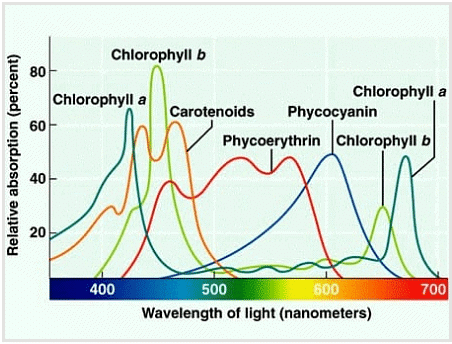
Chlorophyll
- Chlorophyll is the main pigment involved in capturing light in the chloroplasts of most green plants.
- It features a porphyrin ring bound to a magnesium ion and a phytol chain.
- Chlorophyll's alternating single and double bonds allow it to effectively absorb light energy.
- It is present in the cytoplasmic membranes of photosynthetic bacteria or in the thylakoid membranes of plant chloroplasts.
Bacteriorhodopsin
- Bacteriorhodopsin, found only in halobacteria, is a photosynthetic pigment made of a protein linked to a retinal prosthetic group. This pigment absorbs light photons, causing a conformational change in the protein that expels protons from the cell.
Phycobilins
- Cyanobacteria and red algae use phycobilins, such as phycoerythrobilin and phycocyanobilin, as light-harvesting pigments.
- These pigments have an extended polyene system but lack the cyclic structure and central magnesium found in chlorophylls.
- Phycobilins are bound to specific proteins to form phycobiliproteins, which assemble into phycobilisomes, the primary light-harvesting structures in these organisms.
Carotenoids
- In addition to chlorophylls, thylakoid membranes contain carotenoids, which are secondary light-absorbing pigments.
- Carotenoids can be yellow, red, or purple.
- Key examples include β-carotene (a red-orange isoprenoid) and lutein (a yellow carotenoid).
- Carotenoids absorb light at wavelengths not captured by chlorophylls, making them supplementary light receptors.
Factors Affecting Photosynthesis
Blackman formulated the Law of Limiting Factors while studying the factors affecting the rate of photosynthesis. This law states that the rate of a physiological process will be limited by the factor that is in the shortest supply. Similarly, the rate of photosynthesis is influenced by several factors, including:
Light:
- As light intensity increases, the rate of light-dependent reactions and, consequently, the rate of photosynthesis increases.
- Higher light intensity results in more photons falling on a leaf, leading to more chlorophyll molecules being ionized and more ATP and NADPH being generated.
- However, beyond a certain point, the rate of photosynthesis plateaus as light intensity continues to increase because another factor becomes limiting.
- The wavelength of light also impacts the rate of photosynthesis, as different photosynthetic systems absorb light more effectively at different wavelengths.
Carbon Dioxide:
- An increase in the concentration of carbon dioxide enhances the rate at which carbon is incorporated into carbohydrates during the light-independent reactions of photosynthesis.
- Increasing atmospheric carbon dioxide concentration boosts the rate of photosynthesis until another factor becomes limiting.
Temperature:
- The light-independent reactions of photosynthesis, which are enzyme-catalyzed, are affected by temperature changes, whereas the light-dependent reactions are not.
- The rate of these reactions increases as the enzymes approach their optimum temperature. However, beyond this optimum, the rate decreases as the enzymes begin to denature.
Steps of Photosynthesis
The process of photosynthesis can be divided into four main steps:
Absorption of Light The initial step of photosynthesis involves chlorophylls in the thylakoid membranes of chloroplasts absorbing light. This absorbed light energy is used to extract electrons from water, producing oxygen. These electrons are then transferred to a primary electron acceptor, quinone (Q), similar to CoQ in the electron transport chain.
Electron Transfer The electrons move from the primary electron acceptor through a series of electron transfer molecules embedded in the thylakoid membrane, ultimately reaching NADP+ as the final electron acceptor. During this electron transfer process, protons are pumped across the membrane, creating a proton gradient.
Generation of ATP Protons flow from the thylakoid lumen to the stroma through the F0F1 complex, driving the synthesis of ATP from ADP and inorganic phosphate (Pi). This process is analogous to ATP generation in the electron transport chain.
Carbon Fixation The ATP and NADPH produced in the previous steps are used to convert carbon dioxide into six-carbon sugar molecules. This step involves reducing carbon and does not directly depend on light energy, so it is referred to as the dark reactions.
Types, Stages, Parts of photosynthesis
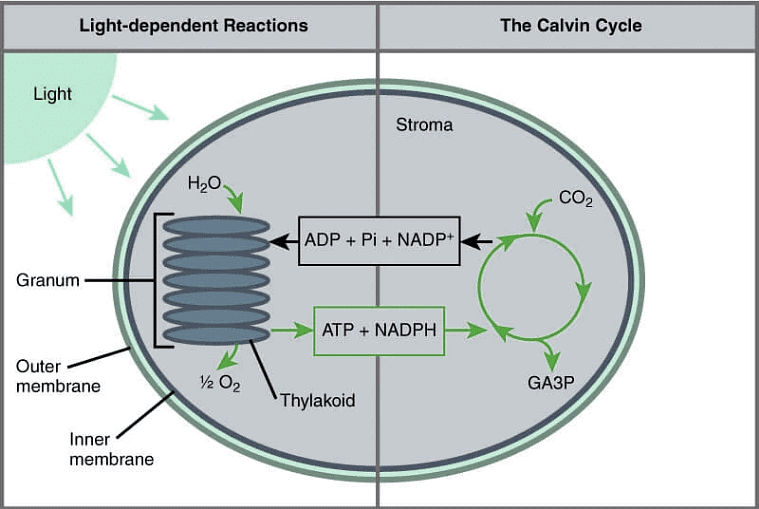
Light-Dependent Reactions These reactions require light and occur in the thylakoid membranes. Here, chlorophyll and other pigments absorb light energy, which is stored as ATP and NADPH, while oxygen is released. Light energy excites electrons in chlorophyll, initiating the transformation of light energy into chemical energy.
Photosystem II: This complex of proteins and pigments absorbs light energy and transfers electrons through a series of molecules until they reach an electron acceptor. Photosystem II contains chlorophyll molecules known as P680, which absorb light at 680 nm. These chlorophyll molecules donate electrons after absorbing light, resulting in the oxidation of P680. An enzyme then splits water into electrons, hydrogen ions, and oxygen. The electrons replace those lost by P680, restoring it to its original state.
Photosystem I: This complex operates similarly to Photosystem II but contains chlorophyll molecules called P700, which absorb light at 700 nm. After absorbing light, Photosystem I transfers electrons, which are eventually used to reduce NADP+ to NADPH.
Reaction: 2 H2O + 2 NADP+ + 3 ADP + 3 Pi + light → 2 NADPH + 2 H+ + 3 ATP + O2
Light-Independent Reactions (Calvin Cycle) These reactions do not directly require light but use the ATP and NADPH produced during the light-dependent reactions to synthesize glucose. This stage involves three key steps:
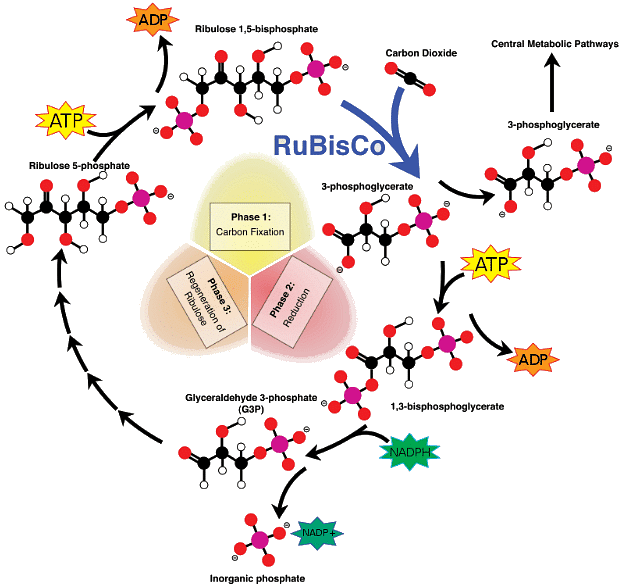
Step 1: Fixation of CO2: Carbon dioxide is attached to ribulose 1,5-bisphosphate (RuBP) by the enzyme ribulose-1,5-bisphosphate carboxylase/oxygenase (Rubisco). This forms a six-carbon compound that splits into two molecules of 3-phosphoglycerate (3-PGA).
Step 2: Conversion to Glyceraldehyde-3-Phosphate: 3-PGA is converted into glyceraldehyde-3-phosphate (G3P) through two reactions. First, ATP transfers a phosphate group to 3-PGA, producing 1,3-bisphosphoglycerate. Next, NADPH donates electrons to this compound, forming G3P. Most of the G3P is used to regenerate RuBP, while the remaining G3P is used to synthesize glucose or stored as starch.
Step 3: Regeneration of RuBP: The three-carbon compounds from the previous steps are converted back into the five-carbon RuBP through a series of transformations involving sugars with three, four, five, six, and seven carbons. This regeneration completes the cycle, enabling continuous carbon fixation.
Reaction: 3 CO2 + 9 ATP + 6 NADPH + 6 H+ → glyceraldehyde-3-phosphate (G3P) + 9 ADP + 8 Pi + 6 NADP+ + 3 H2O
To produce one glucose molecule, two G3P molecules are required, meaning the Calvin Cycle must turn six times to yield one glucose molecule.
Products of Photosynthesis
Light-Dependent Reactions: The outcomes of the light-dependent reactions of photosynthesis include:
- ATP
- NADPH
- Oxygen (O2)
- Hydrogen ions (H+)
Light-Independent Reactions (Calvin Cycle): The products of the Calvin cycle, or light-independent reactions, are:
- Glyceraldehyde-3-phosphate (G3P) or glucose (carbohydrates)
- Hydrogen ions (H+)
Overall Products of Photosynthesis: The overall products of photosynthesis are:
- Glucose (carbohydrates)
- Water
- Oxygen
- Sulfur (in photosynthetic sulfur bacteria)
Examples of Photosynthesis
- Photosynthesis in Green Plants and Oxygenic Bacteria: In green plants and oxygenic bacteria such as cyanobacteria, photosynthesis occurs in the presence of chlorophyll. This process takes place in the thylakoid membranes of chloroplasts, producing oxygen gas, glucose, and water.
- Photosynthesis in Sulfur Bacteria: In purple sulfur bacteria, photosynthesis uses hydrogen sulfide instead of water. Some of these bacteria, like green sulfur bacteria, have chlorophyll, while others, such as purple sulfur bacteria, use carotenoids as photosynthetic pigments. The products of photosynthesis in these bacteria include carbohydrates (not necessarily glucose), sulfur gas, and water.
Importance of Photosynthesis
- Photosynthesis is crucial for autotrophs, allowing them to produce their own food using carbon dioxide, sunlight, and photosynthetic pigments.
- It is equally vital for heterotrophs, which rely on autotrophs for their energy.
- In plants, photosynthesis is essential for maintaining atmospheric oxygen levels and contributes to the carbon cycle in oceans, land, plants, and animals.
- Additionally, it supports the symbiotic relationships between plants, animals, and humans.
- Sunlight, the primary energy source for all life on Earth, is harnessed through photosynthesis.
Artificial Photosynthesis
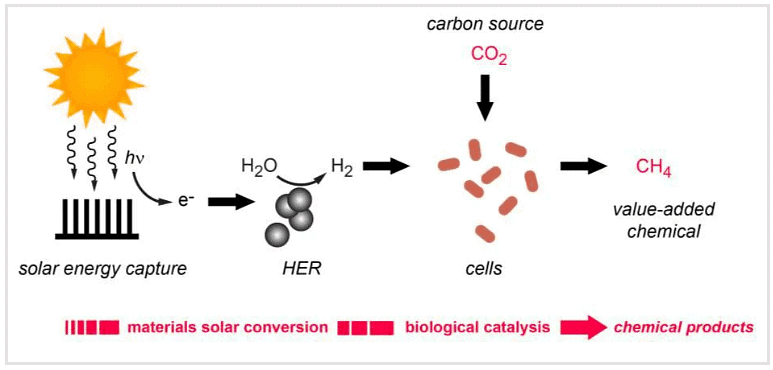
- Artificial photosynthesis is a chemical process that replicates natural photosynthesis by using sunlight, water, and carbon dioxide to produce oxygen and carbohydrates. This process employs photocatalysts to mimic the oxidation-reduction reactions of natural photosynthesis.
- The main goal of artificial photosynthesis is to create solar fuels from sunlight that can be stored and used when sunlight is unavailable. Artificial photosynthesis can produce oxygen from water and sunlight, providing a clean energy source. A key component is the photocatalytic splitting of water into oxygen and hydrogen gas. Additionally, light-driven carbon reduction can be used to simulate natural carbon fixation, producing carbohydrate molecules.
- Applications of artificial photosynthesis include the production of solar fuels, photoelectrochemistry, enzyme engineering, and the development of photoautotrophic microorganisms for generating microbial biofuel and biohydrogen from sunlight.
Photosynthesis vs. Cellular Respiration
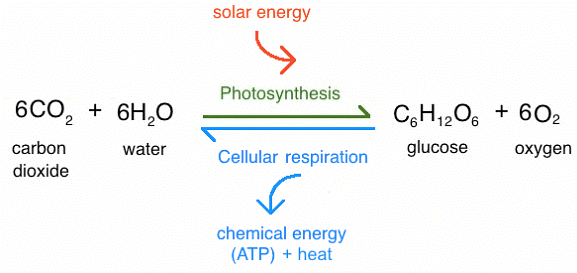
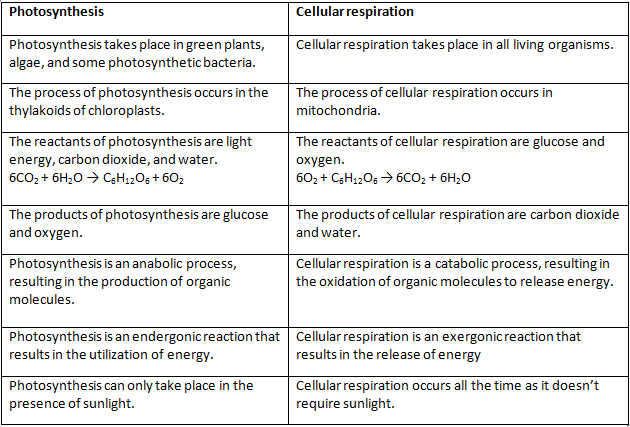
|
468 videos|1404 docs|395 tests
|
FAQs on Photosynthesis - General Awareness for SSC CGL
| 1. What are the main photosynthetic pigments involved in the process? |  |
| 2. How do factors like light intensity and temperature affect the rate of photosynthesis? |  |
| 3. What are the steps involved in the process of photosynthesis? |  |
| 4. What are the products of photosynthesis? |  |
| 5. How does artificial photosynthesis differ from natural photosynthesis? |  |





















